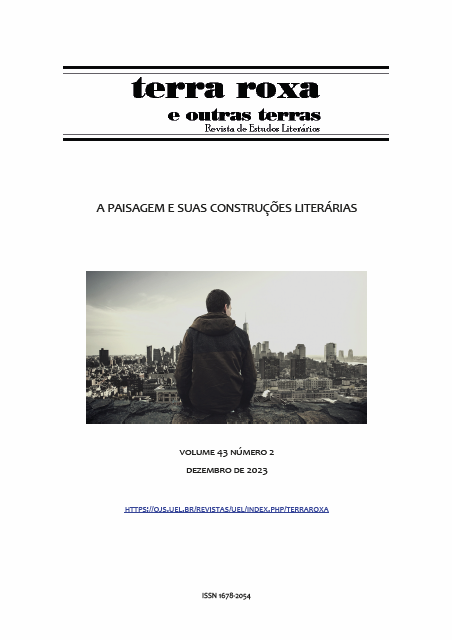Crooked mouths: sertanejo naturalism and drought literature in Brazil
DOI:
https://doi.org/10.5433/1678-2054.2023vol43n2p90Keywords:
Sertão, Os Retirantes, Ataliba o Vaqueiro, Northern LiteratureAbstract
The end of the 19th century saw a shift in the discourse surrounding the sertão in Brazilian literature. Changes both political and aesthetic influenced this process, but the tragic episode of the drought of 1877-1880 ultimately transformed the way in which the rest of Brazil saw the sertão and, consequently, the Northeastern region. Above all, it was from this event on that literary works set in the Northeastern sertão began to represent this space under a strictly negative lens, a tendency that would prove hegemonic in the production of discourse regarding the sertão even beyond the literary form. The works Os Retirantes (1879) and Ataliba o Vaqueiro (1878) were two of the most representatives of what would be called the Drought Literature", being associated by Franklin Távora to hat he would propose as a "sertanejo naturalism", a kind of transition literature between Romanticism and "pure" naturalism associated with regional elements. The understanding of said labeling and the comparison between both texts offers a fertile path through which to understand the historical process of the discursive construction of the sertão by literature.
Downloads
References
AGUIAR, Cláudio. Franklin Távora e o Seu Tempo. São Caetano do Sul: Ateliê, 1997.
ALBUQUERQUE JÚNIOR, Durval Muniz de. As imagens retirantes. A constituição da figurabilidade da seca pela literatura do final do século XIX e do início do século XX. Varia História, Belo Horizonte, v. 33, n. 61, p. 225-251, 2017. DOI: https://doi.org/10.1590/0104-87752017000100010
ALENCAR, José de. Benção Paterna. Obras de Ficção de José de Alencar. V. XII. Rio de Janeiro: José Olympio, 1951.
ALMEIDA, José Maurício Gomes de. A Tradição Regionalista no Romance Brasileiro. Rio de Janeiro: Achiamé, 1981.
ALONSO, Angela. Idéias em Movimento: A Geração de 1870 na Crise do Brasil-Império. São Paulo: Paz e Terra, 2002.
CASTELO BRANCO, Francisco Gil. Ataliba, o Vaqueiro. Ataliba, o Vaqueiro e Outros Escritos. Teresina: Academia Piauiense de Letras, 2016.
CRISTÓVÃO, Fernando. A transfiguração da realidade sertaneja e a sua passagem a mito (A Divina Comédia do Sertão). Revista USP, São Paulo, n. 20, p. 42-53, 1994. DOI: https://doi.org/10.11606/issn.2316-9036.v0i20p42-53
MILTON, John. Paraíso Perdido. São Paulo: Editora 34, 2018.
NEVES, Frederico de Castro. A miséria na literatura: José do Patrocínio e a seca de 1878 no Ceará. Tempo, Niterói, v. 11, n. 22, p. 80-97, 2007. DOI: https://doi.org/10.1590/S1413-77042007000100005
PATROCÍNIO, José do. Os Retirantes. São Paulo: Clube de Autores, 2018.
ROMERO, Sílvio. O Naturalismo em Literatura. São Paulo: Typographia da Província de São Paulo, 1882.
ROMERO, Sílvio. Prefácio. Tobias Barreto. Vários Escritos. Rio de Janeiro: Laemmert, 1900. ix-lii.
SEVCENKO, Nicolau. Literatura Como Missão. São Paulo: Brasiliense, 1999,
TÁVORA, Franklin. Cartas a Cincinato: estudos críticos por Semprônio. Org. Eduardo Vieira Martins. Campinas: Editora da Unicamp, 2011.
TÁVORA, Franklin. Escriptores do Norte do Brazil. A Semana, Rio de Janeiro, v. III, n. 156, 24 de dezembro de 1887. Disponível em: http://memoria.bn.br/DocReader/DocReader.aspx?bib=383422&pagfis=1236.
TÁVORA, Franklin. O Cabeleira. Rio de Janeiro: Typographia Nacional, 1876.
Downloads
Published
How to Cite
Issue
Section
License
Copyright (c) 2023 Mateus de Novaes Maia, Claudete Daflon dos Santos

This work is licensed under a Creative Commons Attribution 4.0 International License.
Authors who publish in this journal agree to the following terms:
a) The authors retain the copyright and grant the journal the right of first publication, the work being simultaneously licensed under the Creative Commons Attribution-NonCommercial 4.0 International License, allowing the sharing of the work with acknowledgment of the authorship of the work and initial publication in this journal.
b) Authors are authorized to assume additional contracts separately, for non-exclusive distribution of the version of the work published in this journal (eg, publish in an institutional repository or as a book chapter), with acknowledgment of authorship and initial publication in this journal.
c) Authors are allowed and encouraged to publish and distribute their work online (e.g. in institutional repositories or on their personal page) after the editorial process, as this can generate productive changes as well as increase impact and citation of the published work (See The Effect of Open Access).
d) The authors of the approved works authorize the journal to, after publication, transfer their content for reproduction in content indexers, virtual libraries and the like.
e) The authors assume that the texts submitted for publication are of their original creation, taking full responsibility for their content in case of any objection by third parties.




















